Two Week Notice Letter Template for Easy Job Resignation
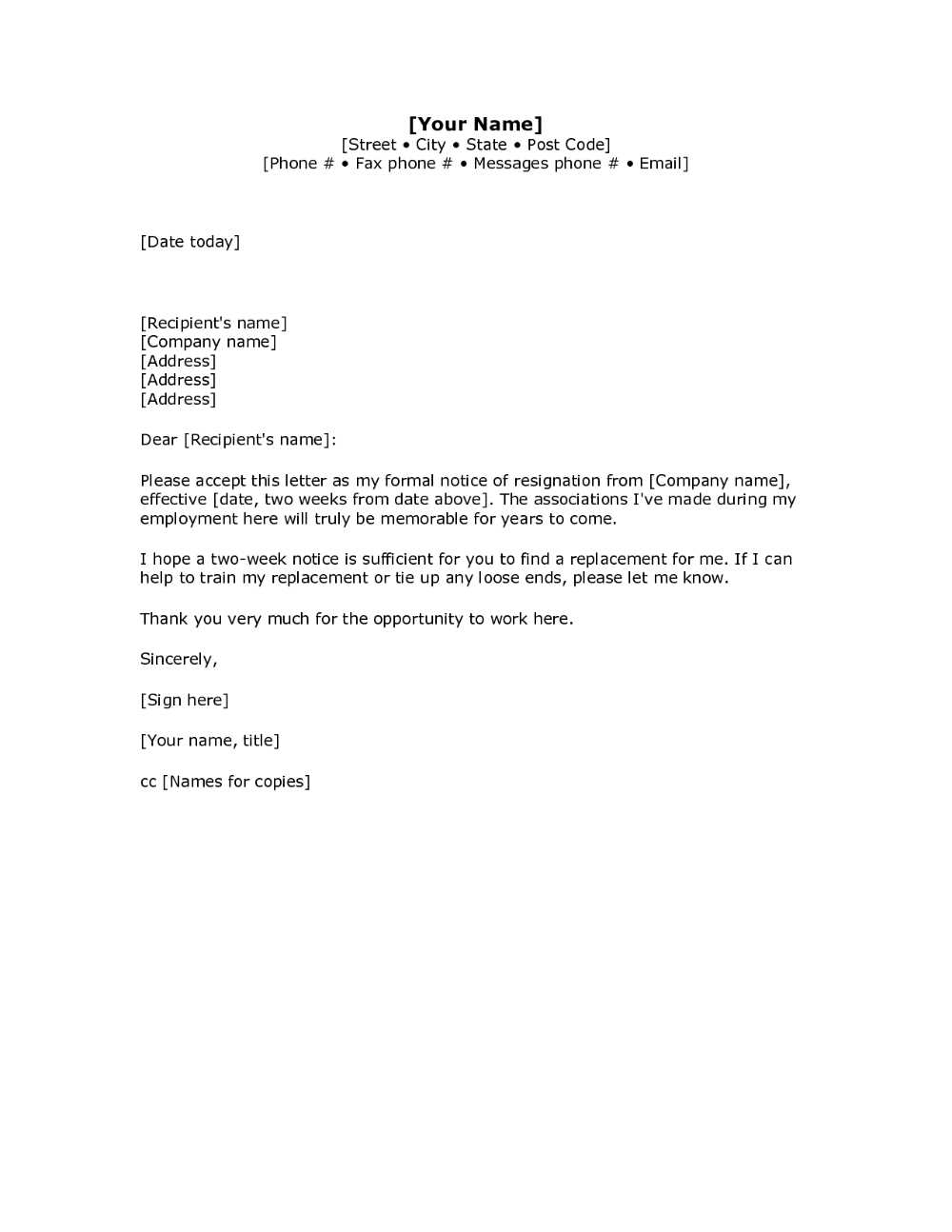
When preparing to part ways with your current employer, it’s important to provide ample time for a smooth transition. A professional way to inform your organization of your intent to leave is by submitting a written document, expressing your decision and outlining your planned departure. This formal announcement ensures clarity and allows your employer to begin preparing for your absence.
Timely submission of this communication is a key element in fostering goodwill and maintaining a positive relationship. It gives both parties the chance to address any outstanding issues, hand over responsibilities, and tie up loose ends. Additionally, such a document reflects your professionalism and respect for the company’s processes.
While many formats exist, it’s essential that the content is concise, direct, and respectful. It should convey your gratitude for the opportunity, confirm your commitment to completing current duties, and provide a clear timeline for your departure. By adhering to these principles, you ensure a respectful exit from your position.
How to Write a Formal Resignation Document
Leaving a position requires careful thought and proper communication. It’s essential to provide your employer with a formal written statement of your intent to step down, giving them the necessary information to plan for your departure. A well-crafted resignation message can help maintain a positive relationship, ensuring a smooth transition for both you and your employer.
Key Elements to Include
First, your message should begin with a clear declaration of your intent to leave. State your last working day explicitly, making sure there’s no ambiguity regarding the timeline. Be concise but ensure your employer knows exactly when they can expect your departure. Following this, it’s good practice to express gratitude for the opportunity, recognizing any positive experiences or skills gained during your time in the role.
Maintaining Professionalism
While it’s tempting to go into detail about your reasons for leaving, it’s best to keep the tone professional and neutral. Avoid unnecessary negativity or complaints. If you wish to provide feedback, it can be done separately or in person. Keep your message straightforward and courteous, aiming to leave on a positive note with your current employer.
Key Elements of a Professional Document
When preparing a formal document for resignation, certain components are necessary to ensure clarity and professionalism. A well-organized communication not only conveys your intent but also reflects your respect for the company and its processes. Below are the essential elements that should be included in such a communication to make it effective and respectful.
Essential Components
- Clear Statement of Intent – Start by clearly expressing your decision to leave the role. This eliminates any ambiguity about your departure.
- Notice Period – Indicate the date of your final day of work, ensuring the employer has sufficient time to prepare for your exit.
- Gratitude – Acknowledge the opportunity you had with the company, and express appreciation for the skills and experiences you gained during your tenure.
- Offer to Assist with Transition – Mention your willingness to help during the transition phase, including training a replacement or finalizing current projects.
Maintaining Professionalism
- Neutral Tone – Keep your tone polite and objective. Avoid unnecessary explanations or complaints about the job or workplace.
- Concise Language – While it’s important to cover all necessary details, brevity is key. Don’t overload the document with excessive information.
Why Giving Proper Resignation Time is Important
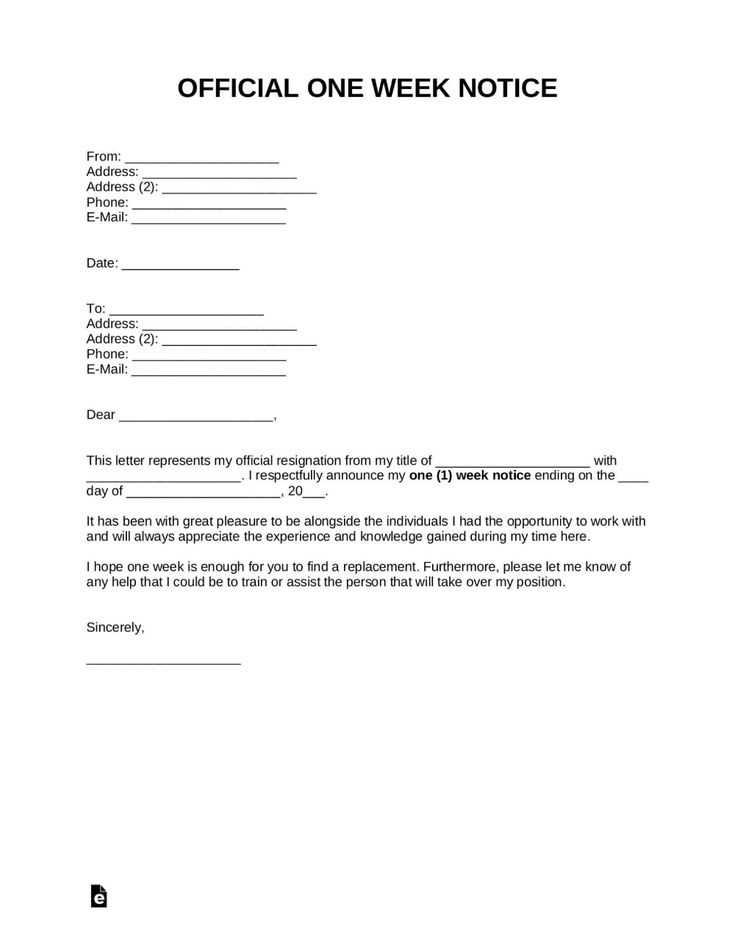
When resigning from a position, providing adequate time before your departure is a critical step. It helps ensure a smoother transition for both you and your employer, allowing the organization to prepare for your exit and find a suitable replacement. This approach not only demonstrates professionalism but also leaves a positive lasting impression with your current employer.
By offering a sufficient amount of time, you give the company the opportunity to manage the impact of your absence, adjust workloads, and complete necessary handovers. It shows respect for the organization’s operations and for your colleagues, who may need to adjust to the change. Additionally, it can strengthen your professional reputation, as leaving on good terms may open doors for future references or job opportunities.
Maintaining Good Relationships with Employers
Leaving a job can be a delicate process, and how you handle your departure can significantly impact your professional reputation. Keeping a positive relationship with your employer is essential, as it ensures that you leave on amicable terms. A respectful and professional exit helps preserve goodwill and can benefit you in future job searches or professional endeavors.
One of the key aspects of leaving on good terms is communication. By expressing gratitude for the opportunity, providing adequate time for transition, and offering support during the handover period, you demonstrate respect for the organization. This not only reflects well on you but also reinforces the professional connections you have made within the company.
| Action | Impact |
|---|---|
| Expressing gratitude | Fosters goodwill and leaves a positive impression |
| Offering help during the transition | Demonstrates professionalism and responsibility |
| Providing proper notice | Helps the company prepare for your absence and shows respect for the organization |
Common Mistakes in Resignation Documents
While drafting a resignation communication, it’s important to avoid common errors that could negatively impact your professional reputation. These mistakes can come across as unprofessional or inconsiderate, and may affect your relationship with the company. Understanding these pitfalls will help ensure your message remains respectful and clear.
Frequent Errors to Avoid
- Giving Insufficient Time – Failing to provide enough time for transition can create confusion and leave your employer unprepared for your departure.
- Being Negative or Complaining – Including complaints about your job, coworkers, or company can leave a bad impression and harm your professional reputation.
- Vagueness About Final Day – Not specifying a clear departure date can cause confusion, leading to miscommunication regarding your last day of work.
- Lack of Gratitude – Not expressing appreciation for the opportunities and experiences gained during your tenure can make your resignation feel abrupt or dismissive.
How to Correct These Mistakes
- Be Clear and Specific – Always provide a definite timeline and ensure your departure date is stated clearly.
- Stay Professional – Keep the tone respectful and positive, focusing on gratitude rather than issues or frustrations.
- Offer Support – Show willingness to assist during the transition period to ensure a smooth handover of responsibilities.
How to Avoid Potential Pitfalls
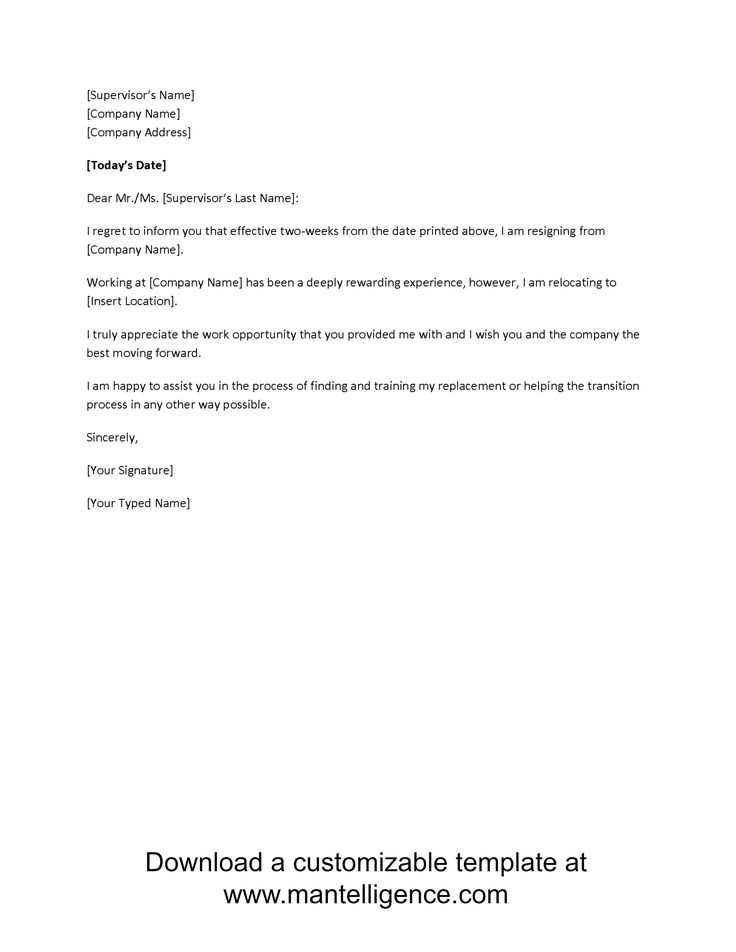
When resigning from a position, it’s essential to handle the process with care to avoid potential misunderstandings or negative consequences. While it’s easy to focus on the details of the message itself, paying attention to the approach and tone is equally important. A thoughtful and respectful departure can leave a lasting positive impression and preserve professional relationships.
Plan Ahead to give your employer sufficient time to prepare for your departure. Rushed or sudden decisions can create unnecessary complications and leave your team in a difficult situation. Ensure your final working day is communicated clearly and early on.
Maintain Professionalism in all aspects of your resignation communication. Avoid expressing frustration or anger, and refrain from criticizing colleagues, the company, or management. A polite and courteous tone will ensure that you leave with dignity, keeping the door open for future opportunities.
Finally, offer assistance with the transition process. Volunteering to help train a successor or wrap up ongoing projects reflects your commitment to the role and respect for your employer’s needs, making the entire process smoother for everyone involved.
When to Submit Your Resignation Document
Timing is an essential factor when deciding to leave a job. Submitting your resignation too early or too late can create confusion or strain relationships with your employer. It’s important to strike the right balance, ensuring that your employer has enough time to make necessary arrangements while also being considerate of your own career needs.
Consider Company Policies
Before submitting your resignation, take time to review any company guidelines or employment contracts that specify a required notice period. Failing to adhere to these terms can result in misunderstandings or even legal consequences. By respecting these guidelines, you demonstrate professionalism and integrity, maintaining a positive relationship with your employer.
Evaluate Your Own Situation
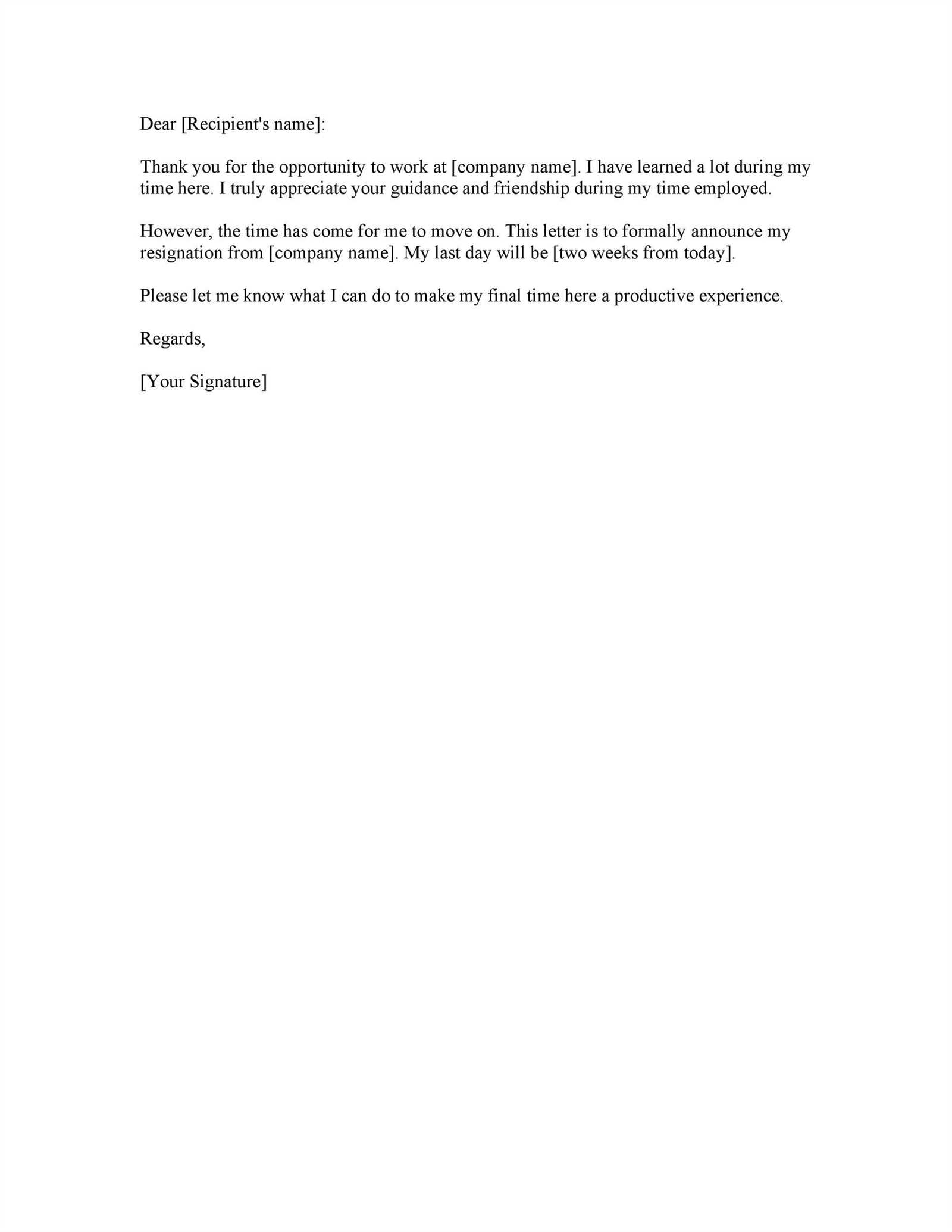
It’s also important to evaluate your personal timeline. Ensure that you are ready for the next phase in your career before submitting your resignation. Consider factors such as securing another position, completing ongoing projects, or resolving personal commitments. Giving yourself ample time to prepare will help ensure a smooth transition for both you and your employer.
Timing and Communication Tips
Choosing the right moment to announce your decision to leave a job is crucial in ensuring a smooth and professional exit. The timing of your resignation can impact both your relationship with your employer and your career. In addition to choosing an appropriate time, clear and respectful communication plays a significant role in leaving on good terms.
Optimal Timing for Resignation
When deciding on the right time to submit your resignation, it’s essential to consider both the needs of your employer and your personal circumstances. Aim to give ample time for a smooth transition, while also making sure you are ready for the next step in your career. Avoid submitting your resignation during busy times, such as the end of a major project or during company-wide events, as this may add unnecessary pressure on your employer and colleagues.
Effective Communication Strategies
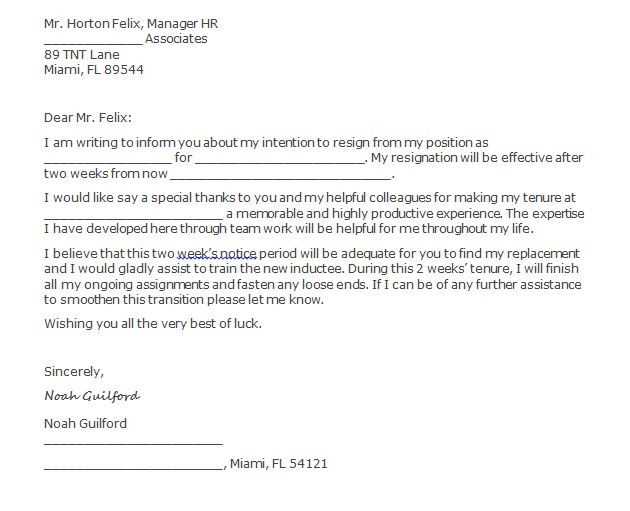
Ensure that your resignation is communicated clearly and professionally. Start by informing your manager in person, if possible, before following up with a written statement. This allows for open dialogue and gives your employer the opportunity to ask questions or discuss the transition. Keep your message concise and positive, focusing on gratitude and appreciation for the experiences and opportunities you gained.